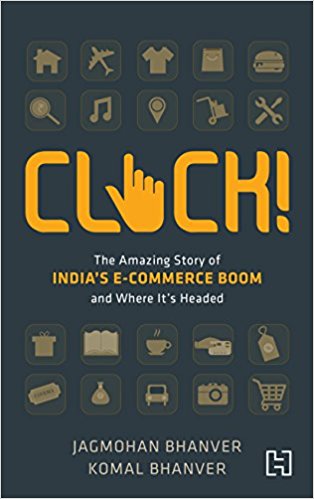Click! The amazing story of India’s e-commerce boom and where it is headed
August 7, 20171.9K views0 comments
Authors Jagmohan & Komal Bhanver have done extensive research about when the first seeds of e-commerce were sown in the 1970s till date. Few will know that it all began in 1971 when the Advanced Research Projects Agency Network was used to arrange a sale of cannabis between students at the Stanford Artificial Intelligence Agency Laboratory and the Massachusetts Institute of Technology. From these initial attempts, the e-commerce activity spread across the world, and in the later decades, in India.
The first wave of e-commerce knocked on India’s doors in 1996 through the first B2B platform (Dinesh Agarwal’s IndiaMART). From 1996-2000, many ‘.com’ companies had mushroomed in the country. But this period was rife with challenges such as low levels of Internet penetration, slow Internet speeds, and the marginal online-shopping user base. After the burst of the dot-com bubble, India saw the second wave of the e-commerce business between 2000 to 2005. Those players who were unable to adapt to the changing business environment had been side-lined. One of the aspects which defined the ‘winners’ was their ability to replicate the offline model in an online space quickly. Brick-and-mortar firms have woken up to this reality and are slowly adopting this to grab a wallet share of the competition. The book has also thrown light on the potential of content marketing, and the shifting platforms from e-commerce to m-commerce and s-commerce.
The book is divided into three sections. First, The Playground, which takes us through the growth of e-commerce, the Internet and where India stood in this scenario. Second, The Game Changers, which is a section dedicated to the insightful journeys of key e-commerce start-ups such as Flipkart, Justdial, Snapdeal, Pepperfry, MakeMyTrip, among others, and their path breaking strategies. The third section, The Battleground, answers key questions related to India’s position in the current e-commerce sector, the various challenges it faces and what factors can impact the growth of this industry.
The increasing use of the Internet and smartphone penetration coupled with changing demographics and growing levels of income have made the Indian e-commerce market a challenging one to survive in. The authors opine that most e-commerce players are likely to transition to the pure marketplace model or a hybrid model. This will encourage the rapid growth of the sector and facilitate more interactions between users and sellers. According to the authors, achieving a greater balance between inventory and costs related to supply chain will be the key to the profitability of any e-commerce company. Just as travel made way for the other categories like e-tailing, classifieds and financial services, these categories will make way for other sectors. Case in point is the education sector, with ‘knowledge’ being the new commodity traded online; the recent US$ 50 Million funding in education technology start-up, Byju’s, through the foundation by Zuckerberg, is a harbinger of the things to come.
The Bhanvers also take a sneak peek into a distant but possible future where a concept called Machine Learning will eventually transform business transactions. Facebook’s newsfeed, Amazon’s recommender engine, personal assistants like Cortana and Siri, among others, are some of the examples of Machine Learning which gives instant, ultra-efficient result surpassing human learning at a given point of time. 3D printing is a reality too; the Chinese have already created a five-storey apartment block and research is already underway to create human bones and organs using this technology!
The book is concise and peppered with examples. Towards the end, it leaves readers to ponder on whether humanized technology, which is tailored to each individual, will bring about the end of the ‘Click’ era. Jagmohan Bhanver, an Executive Coach to CEOs, and Komal Bhanver, an IT professional, together have attempted to author a book which is insightful and makes for an interesting read for those interested in the history and evolution of e-commerce in India.
By Jagmohan & Komal Bhanver, Courtesy Empowering Times
